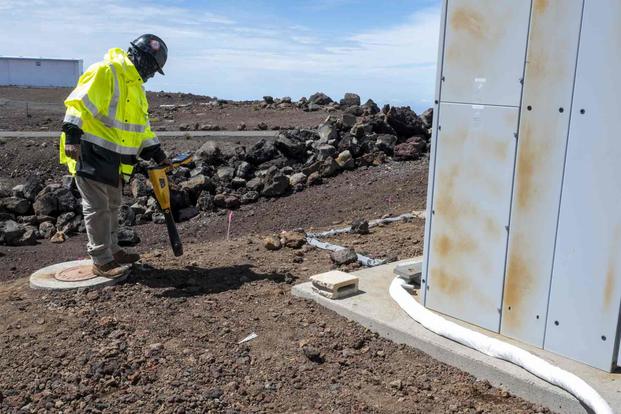A year after 700 gallons of fuel spilled at a Space Force observatory located atop a sacred Hawaiian volcano on Maui, angering locals, officials are still working on approving a remediation plan and presenting it to the community.
On Jan. 29, 2023, a diesel fuel pump for a backup generator at the Maui Space Surveillance Complex failed to shut off and the float -- a piece that helps monitor fuel levels -- inside the tank was defective, causing hundreds of gallons to seep into the soil on the 10,023-foot summit of Haleakalā, a volcano on the Hawaiian island.
Despite gradual progress over the last year, a final plan to make sure all the fuel is cleaned up and determine how the soil will be returned to the land has not been finalized. The service also wants to get community input for the plan, given the sacred nature of the site.
Read Next: As the Marine Corps Says Goodbye to Decades-Old Jet, Its Maintainers Hit the Fleet for the Last Time
"We endeavor to get the community's viewpoint and do our level best to incorporate their concerns and suggestions in the process. We share their frustrations as we work through this complicated, but deliberate, process," Lt. Col. Phillip Wagenbach, 15th Space Surveillance Squadron commander, said in a press release.
"We recognize the cultural importance of the site and have accelerated the process whenever it was safe to do so," he said.
Haleakalā is a culturally and religiously significant site for native Hawaiians, according to the National Park Service. It is considered to be a dwelling for the gods and is a place where priests perform ceremonies.
Part of the delay in cleaning the site is tied to the process of creating a plan that takes into account the cultural and religious significance of the soil, and communicating a plan to local agencies and groups for how to excavate the dirt. That is expected to take several months.
"The next step in the process is to present recommended remedial technologies to the public," a statement from Space Base Delta 1 said. "This information will be shared with the community to solicit inputs before a final remediation method is selected. ... Community inputs will be gathered in person and online during a community forum to be held in the coming months."
In the days immediately following the diesel leak last year, there was a significant amount of outrage from lawmakers and native groups.
Kāko'o Haleakalā, a local protest group, demonstrated at the site, carrying numerous signs, some that read "U.S. Department of Defense Death" and "Time to Haalele" -- which translates as "Time to Desert," according to Ulukua, a Hawaiian electronic library service that provides a dictionary.
The group also posted an online petition titled "End the Maui Space Surveillance Site (MSSS) lease renewal in 2031," which garnered nearly 900 signatures.
The spill prompted Air Force Secretary Frank Kendall to make a nearly 5,000-mile trip from Washington, D.C., to issue a public apology a few weeks later.
"This incident hurts the environment. It harmed our reputation, calls into question the trust placed on us by our local communities," Kendall said last February during the press conference. "To be clear, I apologize for what has happened, and this department will put our full, sustained effort in repairing what has been done."
Workers soon got to work removing an estimated 84,000 pounds of soil. Officials also hired religious and cultural monitors to oversee the project.
On June 16, a contract was awarded to GSI Pacific, a Native Hawaiian-owned company, which took soil samples at depths of 40, 80 and 100 feet in an attempt to build an underground "map of fuel contamination depth and breadth," the service announced.
The data from those samples was compiled in a report which will be reviewed by the Hawaii Department of Health, or DoH.
"The report, currently being reviewed by the Hawaii DoH, indicates the contamination is present above the site-specific cleanup levels to 20 feet below ground surface but poses a very low threat to the drinking water," the service said in a press release Monday.
Once remediation efforts based on that data are made, they'll be presented to the public for input and residents can voice their opinion on the efforts online or during in-person community forums.
The U.S. military has had a strained relationship with native Hawaiians for decades, but recent incidents have spurred more distrust from the local community.
The 700-gallon fuel spill at the Maui Space Surveillance Complex, which is home to the Defense Department's largest optical telescope, according to the Space Force's website, was only a fraction of the 20,000 gallons of jet fuel leaked in a much larger incident at the Navy's Red Hill Bulk Fuel Storage Facility near Honolulu in 2021.
At least 93,000 people living in military housing on and around Pearl Harbor were affected by the massive jet fuel spill. More than 5,000 gallons eventually seeped into the ground and tap water.
That contamination forced thousands to leave their residences, and those who stayed had to rely on bottled water for months. In 2022, the Pentagon announced that the World War II-era bulk fuel farm would be closed and drained.
Military.com reported earlier this month that the Department of Defense plans to develop a registry for residents of Joint Base Pearl Harbor-Hickam to better understand the long-term health impacts. It is still unknown when the registry will be operational, but work on creating it is expected to start later this year.
The situation on Maui differed from Red Hill due to the fact that there are no residents and no water sources at the top of the volcano.
Related: Space Force Still Figuring Out How Bad the Fuel Spill Atop a Sacred Hawaiian Volcano Was












